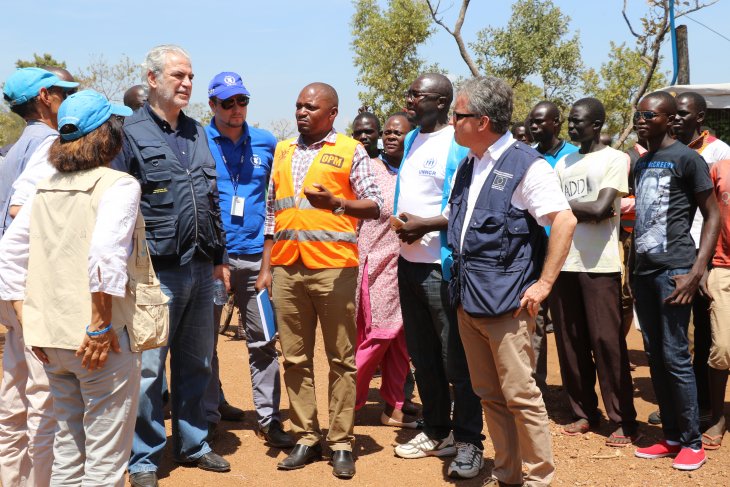Since the 1990s, Western humanitarian organizations have increasingly been concerned with developing tools to assess the efficiency of aid delivery, to establish minimum standards and benchmarks for aid projects, and to convincingly communicate their organizational transparency and accountability to stakeholders.
As an extension of these debates, attempts have been made to carve out common guidelines for how to better conceptualize and operationalize accountability. Legality and morality often conjoin to inform humanitarian actors’ conceptualization of accountability as rules and regulations have determined humanitarian standards, whereas moral stances such as neutrality, independence, humanity and impartiality are supposed to guide operational focus and procedures.

South Sudanese refugees in Uganda. Photo: EU/ECHO/Anouk Delafortrie / Flickr CC BY-ND 2.0
The concept of accountability contains two core components: to be responsible for one’s actions and answering for this responsibility. It is to be understood as a two-way relational process of “being accountable to” and “holding accountable”.
Within the humanitarian regime, accountability has commonly been understood within a model of “upward” and “downward” accountability, which refers to responsibilities flowing between humanitarian actors and their donors and recipients respectively. Upward accountability largely revolves around transparency and donors’ financial control over humanitarian actors, based on a set of predefined criteria, standards and expectations. Downward accountability – that is, the regulatory framework for feedback and interaction between aid providers and recipients – continues to take a back seat when compared to this ever-present emphasis on financial transparency.
Whereas the humanitarian system has long been understood as the sole domain of Western(ized) (international) non-governmental organizations, a range of civic actors are crucial providers of humanitarian aid. Civic actors are embedded in local contexts, engaged in long-term reciprocal relationships, and thus understand the need to mutually negotiate the distribution of responsibilities and expectations.
These realities require us to ask different types of questions about the particular power relations and accountability mechanisms that may be of relevance in such contexts. Understanding accountability as a two-way street of responsibilities that can be anchored in several institutional and relational frameworks, we argue for the need to expand our understandings of humanitarian accountability in terms of “upwards” and “downwards” legal and moral dimensions to include the concept’s relational and contextual dimensions.
Predefined standards versus relational negotiation
When disaster strikes, it is those who are geographically closest who are the first to assist, and these local civic actors often continue to be crucial for alleviating suffering and saving lives. A neighbor, a distant family member, a co-religionist, a local church or mosque, a wealthy businessman or an engaged group of students might be central in guaranteeing the survival of individuals in dire need. By engaging in long-term reciprocal social relationships in local contexts, these individuals and institutions are differently positioned to navigate the many layers of humanitarian accountability. In these contexts, accountability is not derived from one set of standards or predefined criteria. Instead, it develops through a two-way interaction where expectations and responsibilities – cornerstones of humanitarian accountability – are relationally negotiated.
In long-term refugee camps, for instance, INGOs are rarely the only provider of aid. As an example, Lebanon’s biggest Palestinian refugee camp, Ayn el-Hilweh, established in 1948, is host to a vast network of humanitarians. A broad set of actors sustain the camp’s humanitarian infrastructure, including UN agencies, INGOs, NGOs, political parties, religious actors, and an underrecognized set of grassroot initiatives, such as youth movements. These locally present actors are connected internationally to various counterparts, including donors, diaspora individuals and organizations, as well as institutional headquarters. In the camp they engage alongside, in collaboration with, or in opposition to each other, according to everchanging circumstances and motivations. Only rarely do they function as a “humanitarian system.” Instead, they constitute a dynamic fabric, woven together by context rather than shared goals and motivations. Many of these actors will operate with different understandings of accountability: They answer to different actors, and they are held responsible under different sets of expectations. As such, there is an infinite potential for overlapping, and sometimes conflicting, responsibilities and expectations that coexist within the camp’s mere 1.5 square km.
This diversity in aid providers requires us to think differently about how accountability is understood and practiced: Who is held responsible for what? With what expectations? On what grounds? Through what mechanisms? By looking at accountability through the lens of civic humanitarians, it becomes apparent that the responsibilities undergirding this concept always develop out of specific relations, where expectations are grounded in a multitude of social, moral and institutional sources. Given the growing proliferation of civic humanitarian actors, the humanitarian sector might benefit from expanding the traditional understandings of humanitarian accountability.
Relational accountability
Accountability is first and foremost a product of specific relations, and the responsibilities that undergird those. Yet universalistic definitions of accountability, whether in the humanitarian sector or otherwise, continue to dominate and quickly overshadow the way accountability is contextually and relationally situated. Efforts to carve out universal accountability guidelines have diverted attention away from this diversity, and instead directed it towards audits and New Public Management-style results-based monitoring. If humanitarian accountability is to become less of a box-ticking exercise and more of a mechanism to enhance the quality of aid delivery, we need to recognize that responsibilities and expectations develop out of specific relations and not out of operational guidelines.
- This blog post is based on the PRIO Paper “Broadening the Concept of Humanitarian Accountability“